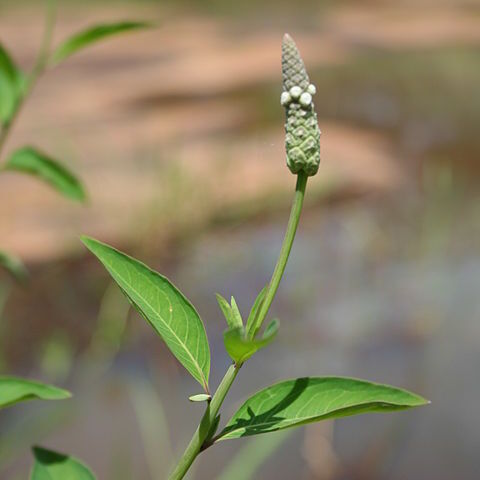Annual herbs; stems glabrous, spongy, 0.5-1.0(-1.3) m tall, usually hollow and widely branched above. Leaf blades entire, ovate to elliptic, mostly 6-12 cm long, 2-3.5(-6) cm wide, obtuse to acute and bluntly mucronate apically, cuneately tapering basally, glabrous; petioles mostly 0.5-2.0 cm long, glabrous. Spikes densely congested with as many as 100 flowers per cluster, cylindric, usually 2.5-8 cm long and 6-9 mm in diameter, terminating the main stems and axes; peduncles 1.5-5(-10) cm long. Flowers sessile, subtended by spatulate bracts with acute to acuminate apices, 2-3 mm long; bracteoles paired, linear, erose-tipped, 2-3 mm long; hypanthium laterally compressed, basally broadly fused to the axis of the spike, thinly cartilaginous at maturity; calyx lobes broadly and bluntly deltoid to suborbicular, 1.5-2.5 mm long, slightly less in width, apically rounded and both erose and scariously tipped, inflexed and partially covering the apex of the capsule at maturity; corolla white, ca. 2.5 mm long, the tube 1-1.5
Roots long, cord-like. Stem hollow, 7-150 cm. Leaves oblong to lanceolate-oblong, attenuate at both ends, acute or obtuse, glabrous, 2½-12½ by ½-5 cm; petiole 3-30 mm. Spikes ¾-7½ cm long, cylindric; peduncle 1-8 cm. Bracts and bracteoles ± spatulate, the green apices arched over the calyx before and after anthesis. Flowers crowded, rhomboid or hexagonal by compression, sessile, wedge-shaped below, attached longitudinally to the rachis by a linear base. Calyx segments deltoid-semicircular, obtuse, ultimately accrescent and connivent. Corolla whitish, 2½-4 mm long, caducous, segments ovate-triangular, obtuse or acute, united slightly more than half-way, connivent. Stamens inserted half-way up tube of corolla, filaments slightly dilated at base. Ovary obovoid, 2½ mm long, apex broad, free, truncate. Capsule 4-5 mm in diam., dehiscing below the calyx segments which fall with the lid, leaving the scarious persistent base. Seeds yellowish-brown, ± ½ mm long.
Roots long, cord-like. Stem hollow, 7-150 cm. Leaves oblong to lanceolate-oblong, attenuate at both ends, acute or obtuse, glabrous, 2½-12½ by ½-5 cm; petiole 3-30 mm. Spikes ¾-7½ cm long, cylindric; peduncle 1-8 cm. Bracts and bracteoles ± spatulate, the green apices arched over the calyx before and after anthesis. Flowers crowded, rhomboid or hexagonal by compression, sessile, wedge-shaped below, attached longitudinally to the rachis by a linear base. Calyx segments deltoid-semicircular, obtuse, ultimately accrescent and connivent. Corolla whitish, 2½-4 mm long, caducous, segments ovate-triangular, obtuse or acute, united slightly more than half-way, connivent. Stamens inserted half-way up tube of corolla, filaments slightly dilated at base. Ovary obovoid, 2½ mm long, apex broad, free, truncate. Capsule 4-5 mm in diam., dehiscing below the calyx segments which fall with the lid, leaving the scarious persistent base. Seeds yellowish-brown, ± ½ mm long.
Annual, erect, glabrous green herb to c. 1 m tall. Stem to 1.5 cm wide, somewhat spongy; roots long, fibrous. Leaves: petiole 1–18 mm long; lamina elliptic or ovate to lanceolate, 1.5–11 cm long, 0.4–3.5 cm wide. Inflorescence a spike, ovoid to lanceoloid or subcylindrical, 0.8–4.5 cm long, 0.4–1 cm wide; bracts spathulate, 2–3 mm long, inflexed over calyx; bracteoles linear, 2–-3 mm long. Calyx tube cupular, c. 1 mm long; lobes 1–1.5 mm long. Corolla white, deciduous; tube 1–1.5 mm long; lobes 5, ovate-triangular, c. 0.5 mm long. Stamens 5, included; filaments glabrous, anthers subsessile. Ovary apically truncate, 2-loculate. Capsule subglobose, 3–4 mm diam. Seed pale brown, 0.5–0.8 mm long, with minute longitudinal ridges.
Plants glabrous throughout. Stems erect, usually branched, 20-70 cm tall, to 1 cm in diam. Leaves petiolate; petiole to 1 cm; leaf blade abaxially gray or green, adaxially green, long elliptic, elliptic-lanceolate, or ovate-lanceolate, 2-9 × 0.5-2 cm, margin entire. Spikes 1-4 cm; bracts ovate, apex acuminate; bracteoles broadly linear. Flowers less than 2 mm. Calyx lobes ovate-orbicular. Corolla white, ca. 1.5 mm, shallowly lobed; lobes patent. Capsule 2-4 mm in diam. Seeds brown-yellow, ca. 0.5 mm. Fl. and fr. all year.
An annual herb. It grows 20-60 cm tall. The stems are much branched. They are hollow. The leaves have stalks. They are alternate and simple. The leaves are 2.5-7.5 cm long and sword shaped. The flowers are arranged in spikes at the tip of the plant. The flowers are white. The fruit is a capsule. It is enclosed in the persistent outer layer of flower parts. The fruit has 2 cells and splits around the middle. There are several seeds.
mm long, the lobes imbricate, triangular, blunt, 1.0-1.2 mm long; filaments fili-form, ca. 0.4 mm long, borne at or just below the middle of the corolla tube, the anthers ca. 0.5 mm long. Capsules circumscissilely dehiscent, 2.5-3.0 mm high, 3-4 mm in diameter; seeds pale yellowish brown, ca. 0.5 mm long, oblong-cylin-dric, lustrous, longitudinally striate with 10-12 ridges, shallowly and indistinctly pitted between the ridges.
Spikes cylindrical–conical, up to 12 cm. long but usually much shorter, and c. 1 cm. in diameter, with only a few flowers open at a time; peduncle up to 8 cm. long; bracts and bracteoles oblanceolate–spathulate, the tips arched over the flowers except at anthesis.
Annual herb, up to 1 m high. Leaves alternate, simple, shortly petioled or subsessile, lanceolate to oblanceolate. Flowers compressed apically in dense, bracteate spikes, white.
Leaf–blade lanceolate to narrowly ovate or elliptic, up to 12 x 5 cm., attenuate at the base, acute or subacute at the apex; petiole up to 1·5 cm. long.
Capsule 4–5 mm. in diameter, dehiscing below the calyx–lobes which fall with the lid, leaving the scarious base persistent on the rhachis.
Corolla white to greenish white or pink, 2–3 mm. long; lobes ovate–triangular, united about half–way.
Flowers sessile, attached longitudinally to the rhachis by a linear base.
Calyx–lobes broadly triangular, rounded at apex, 1–1·5 mm. long.
Filaments slightly dilated at base; anthers c. 0·5 mm. long.
An erect glabrous herb with spongy stems 1-4 ft. high
Seeds yellowish brown, oblong, c. 0·5 mm. long.
Flowers greenish-white in congested spikes
Stem hollow, often much branched.
Ovary obovoid, 1–5–2 mm. long.
Herb, up to 1·5 m. tall.


